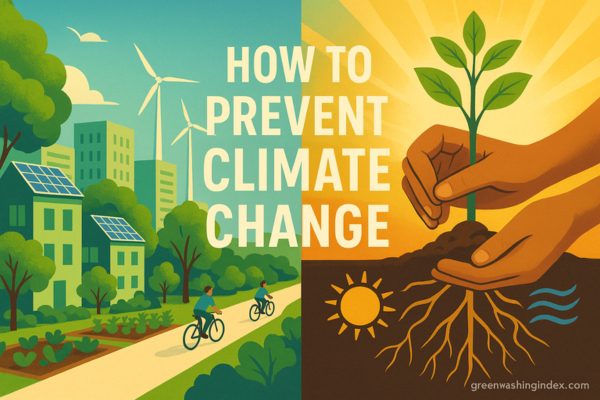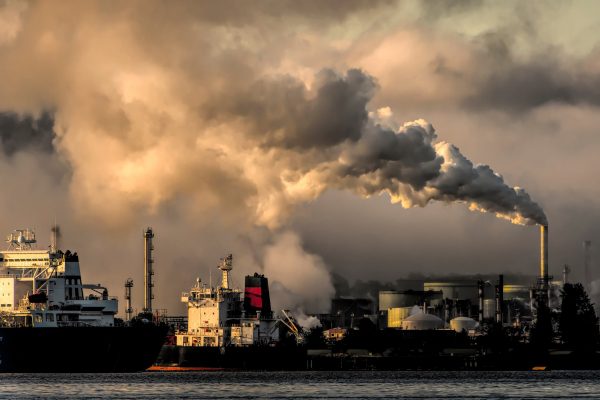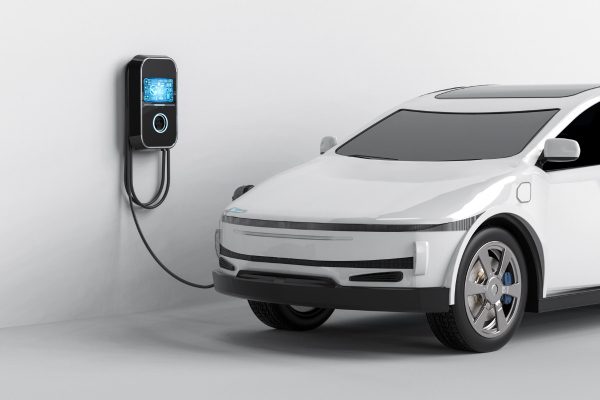

If you’ve searched for “how to prevent weather change,” you’re likely concerned about the dramatic shifts in our climate. While we can’t control daily weather patterns, we absolutely can take action to prevent climate change—the long-term warming that’s causing extreme weather events worldwide.
Here’s the urgent truth: We have until 2030 to limit global warming to 1.5°C. The good news? By combining personal actions that can reduce your emissions by up to 10 tons CO2e per year with pushing for systemic changes, we can still make a meaningful difference.
This guide covers everything from simple home energy solutions to transportation changes, dietary shifts, and how to drive the systemic changes we desperately need. Let’s dive into the most effective ways to combat climate change, starting today.
Many people searching for ways to prevent weather change are actually looking for climate change solutions. Understanding this distinction is crucial for taking effective action.
Weather refers to short-term atmospheric conditions—the daily temperature, precipitation, and wind patterns you experience. Weather naturally fluctuates from day to day and season to season.
While we can’t prevent natural weather variations, we can address the underlying climate crisis that’s making weather more extreme and unpredictable.
Climate change represents long-term shifts in global temperatures and weather patterns. Since the Industrial Revolution, human activities—primarily burning fossil fuels—have dramatically accelerated this warming.
Our atmosphere now contains 42% more carbon dioxide than in pre-industrial times. This greenhouse gas traps heat, causing global temperatures to rise by approximately 1°C already.
The results? More frequent heatwaves, stronger storms, rising sea levels, and disrupted ecosystems that threaten food security and human health.
When we burn coal, oil, and gas, we release carbon dioxide and other greenhouse gases. These gases create a blanket effect in our atmosphere, trapping heat that would normally escape to space.
This process, called the greenhouse effect, is natural and necessary for life. But human activities have supercharged it, causing warming at a rate unprecedented in human history.
Understanding this science empowers us to take targeted actions that actually make a difference in preventing further climate change.
The window for action is closing rapidly. Every fraction of a degree matters, and the decisions we make this decade will determine our planet’s future for centuries.
Americans produce an average of 21 tons of carbon annually—four times the global average. The wealthiest 10% of the global population generates half of all emissions.

These stark numbers highlight both the problem and the opportunity. Those of us in high-emission countries have the greatest potential to reduce our impact through the strategies to deal with climate change outlined in this guide.
The Paris Agreement aims to limit warming to 1.5°C above pre-industrial levels. Scientists agree this requires cutting global emissions by 45% by 2030 and reaching net-zero by 2050.
The EU has committed to reducing emissions by 55% below 1990 levels by 2030. Every nation, company, and individual must contribute to these ambitious but necessary goals.
Missing these targets means more devastating impacts: collapsed ecosystems, mass displacement, and economic chaos that will dwarf today’s challenges.
We’re not talking about distant threats. From 2020 to 2024, the U.S. experienced 115 weather disasters causing over $1 billion in damage each.
Extreme weather events are becoming more frequent and severe. Droughts threaten food supplies, floods displace millions, and heatwaves claim lives.
These impacts fall hardest on vulnerable communities, making climate action a matter of justice as well as survival.
Your home is one of the best places to start making a difference. The right changes can slash your carbon footprint while saving money on energy bills.
Contact your utility company about switching to wind or solar power. Many providers now offer green energy options that can reduce your home’s carbon footprint by up to 1.5 tons CO2e annually.
Can’t switch providers? Consider installing solar panels. While the upfront cost is significant, federal tax credits and long-term savings make this one of the most impactful investments you can make.
Even small steps help. Sign up for community solar programs or purchase renewable energy certificates to support clean energy development.
Old appliances are energy vampires. Replacing them with ENERGY STAR certified models can dramatically reduce your carbon footprint and utility bills.
Start with the biggest energy users: refrigerators, washing machines, and HVAC systems. A new efficient refrigerator alone can save 500 pounds of CO2 annually.
Don’t forget water heaters. Switching from gas to an efficient electric heat pump water heater eliminates direct emissions while cutting energy use by 50% or more.
Poor insulation forces your heating and cooling systems to work overtime. By properly insulating your home, you can reduce your carbon footprint by up to 900 kg CO2e per year.
Start with simple fixes: seal drafts around windows and doors, add weatherstripping, and insulate your attic. These green cleaning habits complement energy efficiency perfectly.
For bigger impact, consider professional energy audits. They’ll identify where your home leaks energy and provide a roadmap for improvements.
Here’s an astounding fact: If every U.S. household replaced just one incandescent bulb with an LED, we’d prevent 7 billion pounds of carbon pollution annually.
LEDs use 75% less energy and last 25 times longer than traditional bulbs. With 40-50 light bulbs in the average American home, the savings potential is enormous.
Start replacing your most-used lights first. The upfront cost pays for itself through energy savings within months.
Transportation accounts for about 29% of U.S. greenhouse gas emissions. Here’s how to make a significant dent in that number.
Living without a car can reduce your carbon footprint by up to 2 tons CO2e per year. In walkable cities, this lifestyle choice is increasingly practical and rewarding.
Start small: commit to car-free days, combine errands, or try a car-free month. Many discover they enjoy the health benefits and community connections that come with walking and cycling.
For those who can’t go completely car-free, reducing driving by even 20% makes a meaningful difference. Every mile not driven helps prevent climate change.
If you need a car, electric vehicles (EVs) offer a cleaner alternative. Switching from gas to electric can save up to 2 tons CO2e annually, even accounting for electricity generation.

EVs are becoming more affordable and practical, with expanding charging networks and improving battery technology. Federal tax credits can offset purchase costs significantly.
Research models carefully. Consider your driving patterns, charging access, and local electricity sources to maximize your environmental benefit.
One round-trip transatlantic flight generates about 2 tons CO2e per passenger—equivalent to months of driving. Reducing air travel is one of the most effective personal ways to help climate change.
When possible, choose virtual meetings, trains, or road trips. If you must fly, book direct flights (takeoffs use the most fuel) and consider purchasing verified carbon offsets.
Some airlines offer more fuel-efficient aircraft and routes. Do your research and vote with your wallet for more sustainable options.
Public transportation reduces emissions by providing shared rides, while walking and cycling produce zero emissions. These options also improve air quality and public health.
| Transportation Mode | Annual CO2 Savings (vs. Driving Alone) |
|---|---|
| Walking/Cycling | 2.0 tons |
| Bus | 1.5 tons |
| Subway/Light Rail | 1.7 tons |
| Carpool (2 people) | 1.0 tons |
Cities worldwide are improving infrastructure for these alternatives. Advocate for better transit and bike lanes in your community—infrastructure shapes behavior.
What we eat has a massive impact on our carbon footprint. Food systems generate about one-third of global greenhouse gas emissions.
Shifting from a typical Western diet to vegetarian can save 500kg CO2e annually. Going vegan increases savings to 900kg—equivalent to taking a small car off the road for two months.
You don’t need to go fully plant-based to make a difference. “Meatless Mondays” or replacing beef with chicken reduces emissions significantly.
Focus on whole foods rather than processed meat substitutes. Beans, lentils, and seasonal vegetables offer nutrition while minimizing environmental impact.
When food rots in landfills, it produces methane—a greenhouse gas 25 times more potent than CO2. Cutting food waste can reduce your carbon footprint by 300kg CO2e annually.

Simple strategies to reduce waste:
Apps can help track expiration dates and suggest recipes for ingredients you have. Small changes in habits yield big environmental benefits.
Choose local and seasonal produce when possible. Food transported long distances generates substantial emissions from refrigeration and fuel.
Support farmers markets and community-supported agriculture (CSA) programs. These direct relationships reduce packaging and transportation while supporting sustainable farming practices.
Avoid products linked to deforestation, like unsustainable palm oil or beef from cleared rainforest areas. Your purchases send market signals about what to do about climate change.
Eating seasonally reduces the energy needed for greenhouse growing and long-distance transport. It also connects you with your local food system and often tastes better.
Learn what grows in your region throughout the year. Preserve abundant summer produce for winter enjoyment through freezing, canning, or drying.
Growing your own food, even herbs on a windowsill, reduces emissions while providing the freshest possible ingredients.
Every purchase is a vote for the kind of world we want. Here’s how to align your consumption with climate goals.
Manufacturing new products generates massive emissions. By buying less and making items last longer, you directly reduce your climate impact.
Before any purchase, ask: Do I really need this? Can I borrow, rent, or buy used? If buying new, choose quality items that will last decades, not seasons.
Learn basic repair skills or support local repair shops. Extending product lifespans is one of the most underrated ways to manage climate change.
The fashion industry produces 10% of global carbon emissions—more than aviation and shipping combined. Fast fashion’s environmental cost is staggering.
Build a smaller wardrobe of quality pieces you love. Shop secondhand first, and when buying new, choose sustainable fashion brands committed to ethical production.
Care for clothes properly to extend their life. Washing in cold water and air-drying saves energy while preserving fabrics.
Zero-waste living minimizes what goes to landfills, reducing methane emissions and resource extraction. Start small with reusable bags, bottles, and containers.
Key zero-waste swaps:
Your money has power. Banks and investment funds that finance fossil fuel projects undermine climate action, regardless of your personal efforts.
Research your bank’s environmental record. Consider switching to institutions committed to sustainable investing and divesting from fossil fuels.
If you have retirement funds or investments, look for ESG (Environmental, Social, Governance) options that align with climate goals.
Nature provides powerful tools for capturing carbon and regulating climate. Supporting these solutions multiplies your positive impact.
Native plants support local ecosystems while requiring less water and maintenance. They also provide crucial habitat for pollinators facing climate pressures.
Trees are carbon-capture machines. A single mature tree absorbs about 48 pounds of CO2 annually. But location matters—plant the right tree in the right place.
Even apartment dwellers can help by supporting urban forestry programs or adopting trees in reforestation projects worldwide.
Forests absorb massive amounts of CO2, but we’re losing them at alarming rates. Supporting conservation efforts is crucial for climate stability.

Choose products certified by the Forest Stewardship Council to ensure sustainable sourcing. Avoid products linked to deforestation.
Support Indigenous land rights. Indigenous peoples protect 80% of the world’s biodiversity despite representing only 5% of the global population.
Oceans absorb about 25% of human CO2 emissions, but this is making them more acidic and threatening marine ecosystems.
Reduce plastic use to protect ocean health. Support sustainable fishing practices and marine protected areas.
Coastal wetlands like mangroves and salt marshes store carbon 10 times more effectively than forests. Supporting their protection offers huge climate benefits.
Cities can be part of the climate solution. Urban gardens, green roofs, and parks reduce the heat island effect while absorbing CO2.
Transform your yard into a climate-friendly landscape with native plants, rain gardens, and minimal lawn area. Skip chemical pesticides and fertilizers.
Community gardens build resilience while reducing food miles. They’re also powerful spaces for education and collective action on how to deal with global warming.
While personal actions matter, systemic change is essential. Here’s how to push for the large-scale transformations we need.
Government policies shape markets and behaviors at scale. Key policies to support include carbon pricing, renewable energy mandates, and building efficiency standards.
Vote for leaders who prioritize climate action. Local elections often have the most direct impact on your daily life through zoning, transportation, and energy decisions.
Support policies that make sustainable choices easier and more affordable for everyone, not just those with privilege.
Many companies make misleading environmental claims while continuing harmful practices. Learn to spot greenwashing and demand real action.
Research companies before supporting them. Look for specific, measurable commitments backed by third-party verification.
Use your voice as a customer. Companies respond to consumer pressure, especially when it’s organized and public.
Transitioning to clean energy requires massive infrastructure changes: upgraded grids, charging networks, and energy storage systems.
Support community solar projects and wind farms. Advocate against new fossil fuel infrastructure in your area.
Push for streamlined permitting processes for renewable energy projects while maintaining environmental protections.
Wealthy nations promised $100 billion annually to help developing countries address climate change. This commitment remains unfulfilled.
Support organizations working on climate justice and international cooperation. Global problems require global solutions.
Understand that climate action in developing nations benefits everyone—emissions don’t respect borders.
Individual actions gain power when multiplied across communities. Here’s how to amplify your impact through collective effort.
Local officials often have more direct impact on your daily life than federal politicians. They control zoning, building codes, and transportation planning.
Attend town halls and planning meetings. Speak up about the need for bike lanes, better transit, and sustainable development.
Write letters, make calls, and request meetings. Politicians track constituent contacts carefully—your voice matters more than you think.
Organizations like 350.org and local climate groups multiply individual efforts into powerful movements for change.
Find groups aligned with your interests—whether that’s renewable energy, sustainable agriculture, or environmental justice.
Even introverts can contribute through behind-the-scenes work like research, writing, or event planning.
Communities working together achieve far more than individuals acting alone. Start or join local initiatives focused on concrete actions.
Successful community climate actions:
These initiatives build resilience while creating the social connections necessary for long-term change.
Talking about climate change normalizes climate action and spreads solutions. Yet many people rarely discuss it, creating a spiral of silence.
Share your climate actions on social media—not to boast, but to inspire and inform others. People need to see that sustainable living is possible and rewarding.
Have compassionate conversations with friends and family. Focus on shared values and co-benefits like health and economic savings.
Misinformation can paralyze action. Let’s address the most common myths that prevent people from taking steps to address climate change.
While systemic change is crucial, individual actions create ripple effects. When you change your behavior, you influence others and shift cultural norms.
Personal actions also build the constituency for policy changes. Politicians are more likely to support climate policies when they see voters taking action.
Your consumer choices send market signals. Companies invest billions tracking and responding to consumer preferences.
Every fraction of a degree matters. The difference between 1.5°C and 2°C of warming means millions more people facing water scarcity, food insecurity, and extreme weather.
We have the technology and knowledge to address climate change. What we need is rapid implementation at scale.
History shows that social changes can happen remarkably quickly when enough people demand them.
Governments are essential, but they respond to pressure from citizens and markets. Your actions create that pressure.
Many climate solutions start at the grassroots level before becoming policy. Community solar, bike-sharing, and composting programs often begin as citizen initiatives.
Businesses, institutions, and individuals control significant emissions. We can’t wait for perfect policies—we need all-hands-on-deck action now.
You can’t manage what you don’t measure. Tracking your progress makes climate action concrete and achievable.
Use reputable calculators that consider your location and lifestyle. The EPA’s carbon footprint calculator provides a good starting point.
Focus on your biggest emission sources first—usually transportation, home energy, and diet. Small changes in these areas yield major results.
Remember that calculators are estimates. The goal isn’t perfection but understanding where you can make the most difference.
Keep a simple log of changes you make and their estimated impact. Seeing progress motivates continued action.
Monthly tracking suggestions:
Celebrate wins and learn from setbacks. Sustainable change happens gradually.
Start with one or two changes and build from there. Trying to transform everything at once often leads to burnout.
Set SMART goals: Specific, Measurable, Achievable, Relevant, and Time-bound. “Reduce home energy use by 20% in six months” beats “use less energy.”
Share goals with friends or family for accountability and support. Making climate action social makes it more likely to stick.
The right tools and connections accelerate your climate journey. Here are essential resources to support your efforts.
Recommended climate apps:
Choose one or two that fit your lifestyle rather than overwhelming yourself with options.
Support groups driving systemic change through donations, volunteering, or amplifying their message:
Research organizations carefully to ensure alignment with your values and effective use of resources.
Stay informed about climate science and solutions through reputable sources:
Knowledge empowers action. Stay curious and keep learning.
The most impactful action varies by person, but for many Americans, reducing car and air travel offers the biggest carbon savings. However, the truly most effective action is using your voice to demand systemic change while making personal changes.
One American taking comprehensive climate action can reduce emissions by 10+ tons CO2e annually. More importantly, your actions influence others, creating multiplier effects. Research shows people are more likely to install solar panels if their neighbors have them.
Many climate actions save money: eating less meat, reducing energy waste, buying used items, and driving less all cut costs. Start with free changes like adjusting your thermostat, taking shorter showers, and eliminating food waste.
Focus on shared values like family, health, and economic security. Discuss local impacts and co-benefits rather than global abstractions. Listen to understand their concerns and find common ground rather than trying to “win” arguments.
Energy production (25%), agriculture (24%), industry (21%), and transportation (14%) are the largest global emitters. However, these sectors exist to serve consumer demand, highlighting the connection between individual choices and systemic change.
Preventing climate change requires urgent action at every level—from personal choices that can save 10+ tons of CO2e annually to the systemic changes we must demand from governments and corporations.
Your top five starting actions:
Remember: we don’t need everyone doing climate action perfectly. We need millions doing it imperfectly but persistently.
Start with one action today. Share your journey with others. Use your voice to demand the systemic changes we desperately need. Together, we can still prevent the worst impacts of climate change and build a sustainable future.
Visit our informative section for more guides on sustainable living, or check our reviews of eco-friendly products that actually work. Your planet needs you—and you have more power than you think.
